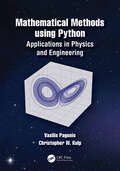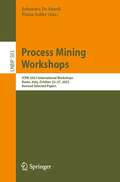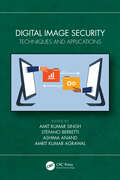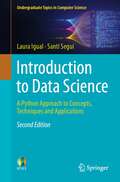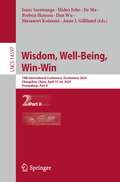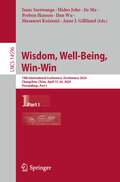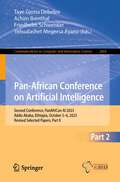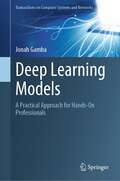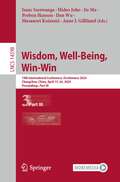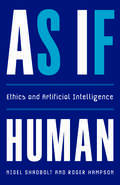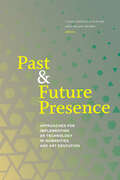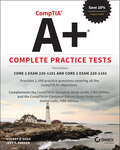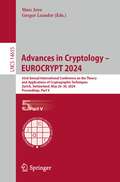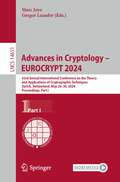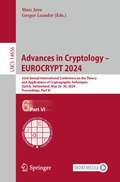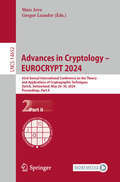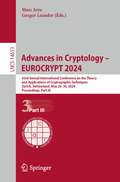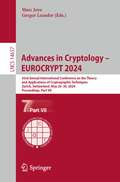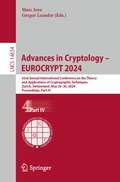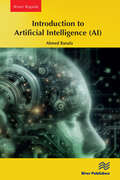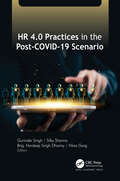- Table View
- List View
Mathematical Methods using Python: Applications in Physics and Engineering
by Vasilis Pagonis Christopher Wayne KulpThis advanced undergraduate textbook presents a new approach to teaching mathematical methods for scientists and engineers. It provides a practical, pedagogical introduction to utilizing Python in Mathematical and Computational Methods courses. Both analytical and computational examples are integrated from its start. Each chapter concludes with a set of problems designed to help students hone their skills in mathematical techniques, computer programming, and numerical analysis. The book places less emphasis on mathematical proofs, and more emphasis on how to use computers for both symbolic and numerical calculations. It contains 182 extensively documented coding examples, based on topics that students will encounter in their advanced courses in Mechanics, Electronics, Optics, Electromagnetism, Quantum Mechanics etc.An introductory chapter gives students a crash course in Python programming and the most often used libraries (SymPy, NumPy, SciPy, Matplotlib). This is followed by chapters dedicated to differentiation, integration, vectors and multiple integration techniques. The next group of chapters covers complex numbers, matrices, vector analysis and vector spaces. Extensive chapters cover ordinary and partial differential equations, followed by chapters on nonlinear systems and on the analysis of experimental data using linear and nonlinear regression techniques, Fourier transforms, binomial and Gaussian distributions. The book is accompanied by a dedicated GitHub website, which contains all codes from the book in the form of ready to run Jupyter notebooks. A detailed solutions manual is also available for instructors using the textbook in their courses.Key Features:· A unique teaching approach which merges mathematical methods and the Python programming skills which physicists and engineering students need in their courses.· Uses examples and models from physical and engineering systems, to motivate the mathematics being taught.· Students learn to solve scientific problems in three different ways: traditional pen-and-paper methods, using scientific numerical techniques with NumPy and SciPy, and using Symbolic Python (SymPy).Vasilis Pagonis is Professor of Physics Emeritus at McDaniel College, Maryland, USA. His research area is applications of thermally and optically stimulated luminescence. He taught courses in mathematical physics, classical and quantum mechanics, analog and digital electronics and numerous general science courses. Dr. Pagonis’ resume lists more than 200 peer-reviewed publications in international journals. He is currently associate editor of the journal Radiation Measurements. He is co-author with Christopher Kulp of the undergraduate textbook “Classical Mechanics: a computational approach, with examples in Python and Mathematica” (CRC Press, 2020). He has also co-authored four graduate-level textbooks in the field of luminescence dosimetry, and most recently published the book “Luminescence Signal analysis using Python” (Springer, 2022).Christopher Kulp is the John P. Graham Teaching Professor of Physics at Lycoming College. He has been teaching undergraduate physics at all levels for 20 years. Dr. Kulp’s research focuses on modelling complex systems, time series analysis, and machine learning. He has published 30 peer-reviewed papers in international journals, many of which include student co-authors. He is also co-author of the undergraduate textbook “Classical Mechanics: a computational approach, with examples in Python and Mathematica” (CRC Press, 2020).
Process Mining Workshops: ICPM 2023 International Workshops, Rome, Italy, October 23–27, 2023, Revised Selected Papers (Lecture Notes in Business Information Processing #503)
by Johannes De Smedt Pnina SofferThis volume constitutes the revised selected papers of several workshops which were held in conjunction with the 5th International Conference on Process Mining, ICPM 2023, held in Rome, Italy, in October 23–27, 2023.The 38 revised full papers presented in this book were carefully reviewed and selected from 85 submissions. The book also contains one invited talk. ICPM 2023 presented the following six workshops:– 4th International Workshop on Event Data and Behavioral Analytics (EdbA)– 4th International Workshop on Leveraging Machine Learning in Process Mining (ML4PM)– 6th International Workshop on Process-Oriented Data Science for Healthcare (PODS4H)– 8th International Workshop on Process Querying, Manipulation, and Intelligence (PQMI)– 2nd International Workshop on Education Meets Process Mining (EduPM)– 2nd International Workshop on Collaboration Mining for Distributed Systems (COMINDS).
Mathematical Methods using Python: Applications in Physics and Engineering
by Vasilis Pagonis Christopher Wayne KulpThis advanced undergraduate textbook presents a new approach to teaching mathematical methods for scientists and engineers. It provides a practical, pedagogical introduction to utilizing Python in Mathematical and Computational Methods courses. Both analytical and computational examples are integrated from its start. Each chapter concludes with a set of problems designed to help students hone their skills in mathematical techniques, computer programming, and numerical analysis. The book places less emphasis on mathematical proofs, and more emphasis on how to use computers for both symbolic and numerical calculations. It contains 182 extensively documented coding examples, based on topics that students will encounter in their advanced courses in Mechanics, Electronics, Optics, Electromagnetism, Quantum Mechanics etc.An introductory chapter gives students a crash course in Python programming and the most often used libraries (SymPy, NumPy, SciPy, Matplotlib). This is followed by chapters dedicated to differentiation, integration, vectors and multiple integration techniques. The next group of chapters covers complex numbers, matrices, vector analysis and vector spaces. Extensive chapters cover ordinary and partial differential equations, followed by chapters on nonlinear systems and on the analysis of experimental data using linear and nonlinear regression techniques, Fourier transforms, binomial and Gaussian distributions. The book is accompanied by a dedicated GitHub website, which contains all codes from the book in the form of ready to run Jupyter notebooks. A detailed solutions manual is also available for instructors using the textbook in their courses.Key Features:· A unique teaching approach which merges mathematical methods and the Python programming skills which physicists and engineering students need in their courses.· Uses examples and models from physical and engineering systems, to motivate the mathematics being taught.· Students learn to solve scientific problems in three different ways: traditional pen-and-paper methods, using scientific numerical techniques with NumPy and SciPy, and using Symbolic Python (SymPy).Vasilis Pagonis is Professor of Physics Emeritus at McDaniel College, Maryland, USA. His research area is applications of thermally and optically stimulated luminescence. He taught courses in mathematical physics, classical and quantum mechanics, analog and digital electronics and numerous general science courses. Dr. Pagonis’ resume lists more than 200 peer-reviewed publications in international journals. He is currently associate editor of the journal Radiation Measurements. He is co-author with Christopher Kulp of the undergraduate textbook “Classical Mechanics: a computational approach, with examples in Python and Mathematica” (CRC Press, 2020). He has also co-authored four graduate-level textbooks in the field of luminescence dosimetry, and most recently published the book “Luminescence Signal analysis using Python” (Springer, 2022).Christopher Kulp is the John P. Graham Teaching Professor of Physics at Lycoming College. He has been teaching undergraduate physics at all levels for 20 years. Dr. Kulp’s research focuses on modelling complex systems, time series analysis, and machine learning. He has published 30 peer-reviewed papers in international journals, many of which include student co-authors. He is also co-author of the undergraduate textbook “Classical Mechanics: a computational approach, with examples in Python and Mathematica” (CRC Press, 2020).
Digital Image Security: Techniques and Applications
by Amit Kumar Singh Stefano Berretti Ashima Anand Amrit Kumar AgrawalThis book will highlight cutting-edge research with a particular emphasis on interdisciplinary approaches, novel techniques, and solutions to provide digital image security for applications in diverse areas. It further discusses important topics such as biometric imaging, big data security and privacy in healthcare, security and privacy in the internet of things, and security in cloud-based image processing.This book Presents new ideas, approaches, theories, and practices with a focus on digital image security and privacy solutions for real-world applications. Discusses security in cloud-based image processing for smart city applications. Provides an overview of innovative security techniques that are being developed to ensure the guaranteed authenticity of transmitted, shared, or stored digital images. Highlights approaches such as watermarking, blockchain, and hashing. to secure digital images in artificial intelligence, machine learning, cloud computing, and temper detection environments. Explains important topics such as biometric imaging, blockchain for digital data security, and protection systems against personal identity theft. It will serve as an ideal reference text for senior undergraduate, graduate students, academic researchers, and professionals in the fields including electrical engineering, electronics, communications engineering, and computer engineering.
Digital Image Security: Techniques and Applications
This book will highlight cutting-edge research with a particular emphasis on interdisciplinary approaches, novel techniques, and solutions to provide digital image security for applications in diverse areas. It further discusses important topics such as biometric imaging, big data security and privacy in healthcare, security and privacy in the internet of things, and security in cloud-based image processing.This book Presents new ideas, approaches, theories, and practices with a focus on digital image security and privacy solutions for real-world applications. Discusses security in cloud-based image processing for smart city applications. Provides an overview of innovative security techniques that are being developed to ensure the guaranteed authenticity of transmitted, shared, or stored digital images. Highlights approaches such as watermarking, blockchain, and hashing. to secure digital images in artificial intelligence, machine learning, cloud computing, and temper detection environments. Explains important topics such as biometric imaging, blockchain for digital data security, and protection systems against personal identity theft. It will serve as an ideal reference text for senior undergraduate, graduate students, academic researchers, and professionals in the fields including electrical engineering, electronics, communications engineering, and computer engineering.
Introduction to Data Science: A Python Approach to Concepts, Techniques and Applications (Undergraduate Topics in Computer Science)
by Laura Igual Santi SeguíThis accessible and classroom-tested textbook/reference presents an introduction to the fundamentals of the interdisciplinary field of data science. The coverage spans key concepts from statistics, machine/deep learning and responsible data science, useful techniques for network analysis and natural language processing, and practical applications of data science such as recommender systems or sentiment analysis. Topics and features: Provides numerous practical case studies using real-world data throughout the book Supports understanding through hands-on experience of solving data science problems using Python Describes concepts, techniques and tools for statistical analysis, machine learning, graph analysis, natural language processing, deep learning and responsible data scienceReviews a range of applications of data science, including recommender systems and sentiment analysis of text data Provides supplementary code resources and data at an associated website This practically-focused textbook provides an ideal introduction to the field for upper-tier undergraduate and beginning graduate students from computer science, mathematics, statistics, and other technical disciplines. The work is also eminently suitable for professionals on continuous education short courses, and to researchers following self-study courses.
Wisdom, Well-Being, Win-Win: 19th International Conference, iConference 2024, Changchun, China, April 15–26, 2024, Proceedings, Part II (Lecture Notes in Computer Science #14597)
by Isaac Sserwanga Hideo Joho Jie Ma Preben Hansen Dan Wu Masanori Koizumi Anne J. GillilandThe Three-volume set LNCS 14596, 14596 and 14598 constitutes the proceedings of the 19th International Conference on Wisdom, Well-Being, Win-Win, iConference 2024, which was hosted virtually by University of Tsukuba, Japan and in presence by Jilin University, Changchun, China, during April 15–26, 2024. The 36 full papers and 55 short papers are presented in these proceedings were carefully reviewed and selected from 218 submissions. The papers are organized in the following topical sections: Volume I: Archives and Information Sustainability; Behavioural Research; AI and Machine Learning; Information Science and Data Science; Information and Digital Literacy. Volume II: Digital Humanities; Intellectual Property Issues; Social Media and Digital Networks; Disinformation and Misinformation; Libraries, Bibliometrics and Metadata. Volume III: Knowledge Management; Information Science Education; Information Governance and Ethics; Health Informatics; Human-AI Collaboration; Information Retrieval; Community Informatics; Scholarly, Communication and Open Access.
Wisdom, Well-Being, Win-Win: 19th International Conference, iConference 2024, Changchun, China, April 15–26, 2024, Proceedings, Part I (Lecture Notes in Computer Science #14596)
by Isaac Sserwanga Hideo Joho Jie Ma Preben Hansen Dan Wu Masanori Koizumi Anne J. GillilandThe Three-volume set LNCS 14596, 14596 and 14598 constitutes the proceedings of the 19th International Conference on Wisdom, Well-Being, Win-Win, iConference 2024, which was hosted virtually by University of Tsukuba, Japan and in presence by Jilin University, Changchun, China, during April 15–26, 2024. The 36 full papers and 55 short papers are presented in these proceedings were carefully reviewed and selected from 218 submissions. The papers are organized in the following topical sections: Volume I: Archives and Information Sustainability; Behavioural Research; AI and Machine Learning; Information Science and Data Science; Information and Digital Literacy. Volume II: Digital Humanities; Intellectual Property Issues; Social Media and Digital Networks; Disinformation and Misinformation; Libraries, Bibliometrics and Metadata. Volume III: Knowledge Management; Information Science Education; Information Governance and Ethics; Health Informatics; Human-AI Collaboration; Information Retrieval; Community Informatics; Scholarly, Communication and Open Access.
Pan-African Conference on Artificial Intelligence: Second Conference, PanAfriCon AI 2023, Addis Ababa, Ethiopia, October 5–6, 2023, Revised Selected Papers, Part II (Communications in Computer and Information Science #2069)
by Taye Girma Debelee Achim Ibenthal Friedhelm Schwenker Yehualashet Megersa AyanoThis two-volume set, CCIS 2068 and 2069, constitutes selected papers presented during the Second Pan-African Conference on Artificial Intelligence, PanAfriCon AI 2023, held in Addis Ababa, Ethiopia, in October 2023. The set goal of the conference is to exchange the best practices of joint Pan-African efforts to provide solutions for Africa’s key 21st century challenges in the social, economic and ecologic domains. The 29 papers were thoroughly reviewed and selected from 134 submissions. The papers are organized in the following topical sections: Medical AI; Natural Language Processing, Text and Speech Processing; AI in Finance and Cyber Security; Autonomous Vehicles; AI Ethics and Life Sciences.
Deep Learning Models: A Practical Approach for Hands-On Professionals (Transactions on Computer Systems and Networks)
by Jonah GambaThis book focuses on and prioritizes a practical approach, minimizing theoretical concepts to deliver algorithms effectively. With deep learning emerging as a vibrant field of research and development in numerous industrial applications, there is a pressing need for accessible resources that provide comprehensive examples and quick guidance. Unfortunately, many existing books on the market tend to emphasize theoretical aspects, leaving newcomers scrambling for practical guidance. This book takes a different approach by focusing on practicality while keeping theoretical concepts to a necessary minimum. The book begins by laying a foundation of basic information on deep learning, gradually delving into the subject matter to explain and illustrate the limitations of existing algorithms. A dedicated chapter is allocated to evaluating the performance of multiple algorithms on specific datasets, highlighting techniques and strategies that can address real-world challenges when deep learning is employed. By consolidating all necessary information into a single resource, readers can bypass the hassle of scouring scattered online sources, gaining a one-stop solution to dive into deep learning for object detection and classification. To facilitate understanding, the book employs a rich array of illustrations, figures, tables, and code snippets. Comprehensive code examples are provided, empowering readers to grasp concepts quickly and develop practical solutions. The book covers essential methods and tools, ensuring a complete and comprehensive coverage that enables professionals to implement deep learning algorithms swiftly and effectively.This book is designed to equip professionals with the necessary skills to thrive in the active field of deep learning, where it has the potential to revolutionize traditional problem-solving approaches. This book serves as a practical companion, enabling readers to grasp concepts swiftly and embark on building practical solutions.
Wisdom, Well-Being, Win-Win: 19th International Conference, iConference 2024, Changchun, China, April 15–26, 2024, Proceedings, Part III (Lecture Notes in Computer Science #14598)
by Isaac Sserwanga Hideo Joho Jie Ma Preben Hansen Dan Wu Masanori Koizumi Anne J. GillilandThe Three-volume set LNCS 14596, 14597 and 14598 constitutes the proceedings of the 19th International Conference on Wisdom, Well-Being, Win-Win, iConference 2024, which was hosted virtually by University of Tsukuba, Japan and in presence by Jilin University, Changchun, China, during April 15–26, 2024. The 36 full papers and 55 short papers are presented in these proceedings were carefully reviewed and selected from 218 submissions. The papers are organized in the following topical sections: Volume I: Archives and Information Sustainability; Behavioural Research; AI and Machine Learning; Information Science and Data Science; Information and Digital Literacy. Volume II: Digital Humanities; Intellectual Property Issues; Social Media and Digital Networks; Disinformation and Misinformation; Libraries, Bibliometrics and Metadata. Volume III: Knowledge Management; Information Science Education; Information Governance and Ethics; Health Informatics; Human-AI Collaboration; Information Retrieval; Community Informatics; Scholarly, Communication and Open Access.
As If Human: Ethics and Artificial Intelligence
by Nigel Shadbolt Roger HampsonA new approach to the challenges surrounding artificial intelligence that argues for assessing AI actions as if they came from a human being Intelligent machines present us every day with urgent ethical challenges. Is the facial recognition software used by an agency fair? When algorithms determine questions of justice, finance, health, and defense, are the decisions proportionate, equitable, transparent, and accountable? How do we harness this extraordinary technology to empower rather than oppress? Despite increasingly sophisticated programming, artificial intelligences share none of our essential human characteristics—sentience, physical sensation, emotional responsiveness, versatile general intelligence. However, Nigel Shadbolt and Roger Hampson argue, if we assess AI decisions, products, and calls for action as if they came from a human being, we can avert a disastrous and amoral future. The authors go beyond the headlines about rampant robots to apply established moral principles in shaping our AI future. Their new framework constitutes a how-to for building a more ethical machine intelligence.
Past and Future Presence: Approaches for Implementing XR Technology in Humanities and Art Education
by Lissa Crofton-Sleigh Brian BeamsWhile uses and studies of XR technology within STEM-based education have been plentiful in recent years, there has been lesser or even, at times, a lack of coverage for this novel learning tool in the arts and humanities.Past and Future Presence aims to bridge some of that gap by presenting research-based theory and case studies of successful application and implementation of XR technology into postsecondary educational settings, ranging in topics from ancient to modern languages, classical and contemporary art, and reenvisioned historical scenes and events presented in ways never seen before. The studies also contemplate how this novel medium can enhance and supplement learning in classrooms and other formal or informal learning environments. The volume as a whole is intended to demonstrate to educators, scholars, and researchers in higher education the potential value of integrating XR technology into their classrooms and to provide a strong argument for college and university administrators to invest in training and development of new research and content for classrooms inside and outside of STEM. The authors of these chapters come from a diverse range of backgrounds at different stages of their careers, providing a broad crosssection of scholastic work within the humanities and arts. Each chapter offers a different angle or approach to incorporating XR technology into teaching or research within different subject areas. As the volume suggests, this technology also places additional emphasis on the humanity within the humanities, by focusing on increasing connection between users and different cultures, time periods, and perspectives.
CompTIA A+ Complete Practice Tests: Core 1 Exam 220-1101 and Core 2 Exam 220-1102
by Audrey O'Shea Jeff T. ParkerImprove your understanding of all Core 1 and Core 2 A+ exam objectives and prepare for a new career as a computer technician The Third Edition of the CompTIA A+ Complete Practice Tests: Core 1 Exam 220-1101 and Core 2 Exam 220-1102 offers aspiring and practicing computer technicians essential and practical exam prep material for the industry favorite A+ certification. The hundreds of domain-by-domain practice questions cover all of the A+ exam objectives tested on the Core 1 and Core 2 exams, helping you prepare for success on the tests and in the real world. Just like the real exams, the practice questions contained within this resource cover mobile devices, networking, hardware, virtualization and cloud computing, hardware and network troubleshooting, operating systems, security, software troubleshooting, and operational procedures. These rigorous and realistic practice questions will get you ready for your first role as a computer technician and let you hit the ground running. This comprehensive set includes: Challenging questions designed to advance your understanding and comprehension of all covered exam domains Questions similar to those found on the real Core 1 and Core 2 A+ exams Access to the Sybex online test bank, with hundreds of questions and full-length practice exams Perfect for anyone prepping for the Core 1 and Core 2 A+ exams, CompTIA A+ Complete Practice Tests: Core 1 Exam 220-1101 and Core 2 Exam 220-1102 is also an ideal resource for aspiring and early-career computer technicians who want to improve their understanding of some of the foundational concepts they rely on each day in the field. And save 10% when you purchase your CompTIA exam voucher with our exclusive WILEY10 coupon code.
Advances in Cryptology – EUROCRYPT 2024: 43rd Annual International Conference on the Theory and Applications of Cryptographic Techniques, Zurich, Switzerland, May 26–30, 2024, Proceedings, Part V (Lecture Notes in Computer Science #14655)
by Marc Joye Gregor LeanderThe 7-volume set LNCS 14651 - 14657 conference volume constitutes the proceedings of the 43rd Annual International Conference on the Theory and Applications of Cryptographic Techniques, EUROCRYPT 2024, held in in Zurich, Switzerland, in May 2024. The 105 papers included in these proceedings were carefully reviewed and selected from 500 submissions. They were organized in topical sections as follows: Part I: Awarded papers; symmetric cryptology; public key primitives with advanced functionalities; Part II: Public key primitives with advances functionalities; Part III: AI and blockchain; secure and efficient implementation, cryptographic engineering, and real-world cryptography; theoretical foundations; Part IV: Theoretical foundations; Part V: Multi-party computation and zero-knowledge; Part VI: Multi-party computation and zero-knowledge; classic public key cryptography, Part VII: Classic public key cryptography.
Advances in Cryptology – EUROCRYPT 2024: 43rd Annual International Conference on the Theory and Applications of Cryptographic Techniques, Zurich, Switzerland, May 26–30, 2024, Proceedings, Part I (Lecture Notes in Computer Science #14651)
by Marc Joye Gregor LeanderThe 7-volume set LNCS 14651 - 14657 conference volume constitutes the proceedings of the 43rd Annual International Conference on the Theory and Applications of Cryptographic Techniques, EUROCRYPT 2024, held in in Zurich, Switzerland, in May 2024. The 105 papers included in these proceedings were carefully reviewed and selected from 500 submissions. They were organized in topical sections as follows: Part I: Awarded papers; symmetric cryptology; public key primitives with advanced functionalities; Part II: Public key primitives with advances functionalities; Part III: AI and blockchain; secure and efficient implementation, cryptographic engineering, and real-world cryptography; theoretical foundations; Part IV: Theoretical foundations; Part V: Multi-party computation and zero-knowledge; Part VI: Multi-party computation and zero-knowledge; classic public key cryptography, Part VII: Classic public key cryptography.
Advances in Cryptology – EUROCRYPT 2024: 43rd Annual International Conference on the Theory and Applications of Cryptographic Techniques, Zurich, Switzerland, May 26–30, 2024, Proceedings, Part VI (Lecture Notes in Computer Science #14656)
by Marc Joye Gregor LeanderThe 7-volume set LNCS 14651 - 14657 conference volume constitutes the proceedings of the 43rd Annual International Conference on the Theory and Applications of Cryptographic Techniques, EUROCRYPT 2024, held in in Zurich, Switzerland, in May 2024. The 105 papers included in these proceedings were carefully reviewed and selected from 500 submissions. They were organized in topical sections as follows: Part I: Awarded papers; symmetric cryptology; public key primitives with advanced functionalities; Part II: Public key primitives with advances functionalities; Part III: AI and blockchain; secure and efficient implementation, cryptographic engineering, and real-world cryptography; theoretical foundations; Part IV: Theoretical foundations; Part V: Multi-party computation and zero-knowledge; Part VI: Multi-party computation and zero-knowledge; classic public key cryptography, Part VII: Classic public key cryptography.
Advances in Cryptology – EUROCRYPT 2024: 43rd Annual International Conference on the Theory and Applications of Cryptographic Techniques, Zurich, Switzerland, May 26–30, 2024, Proceedings, Part II (Lecture Notes in Computer Science #14652)
by Marc Joye Gregor LeanderThe 7-volume set LNCS 14651 - 14657 conference volume constitutes the proceedings of the 43rd Annual International Conference on the Theory and Applications of Cryptographic Techniques, EUROCRYPT 2024, held in in Zurich, Switzerland, in May 2024. The 105 papers included in these proceedings were carefully reviewed and selected from 500 submissions. They were organized in topical sections as follows: Part I: Awarded papers; symmetric cryptology; public key primitives with advanced functionalities; Part II: Public key primitives with advances functionalities; Part III: AI and blockchain; secure and efficient implementation, cryptographic engineering, and real-world cryptography; theoretical foundations; Part IV: Theoretical foundations; Part V: Multi-party computation and zero-knowledge; Part VI: Multi-party computation and zero-knowledge; classic public key cryptography, Part VII: Classic public key cryptography.
Advances in Cryptology – EUROCRYPT 2024: 43rd Annual International Conference on the Theory and Applications of Cryptographic Techniques, Zurich, Switzerland, May 26–30, 2024, Proceedings, Part III (Lecture Notes in Computer Science #14653)
by Marc Joye Gregor LeanderThe 7-volume set LNCS 14651 - 14657 conference volume constitutes the proceedings of the 43rd Annual International Conference on the Theory and Applications of Cryptographic Techniques, EUROCRYPT 2024, held in in Zurich, Switzerland, in May 2024. The 105 papers included in these proceedings were carefully reviewed and selected from 500 submissions. They were organized in topical sections as follows: Part I: Awarded papers; symmetric cryptology; public key primitives with advanced functionalities; Part II: Public key primitives with advances functionalities; Part III: AI and blockchain; secure and efficient implementation, cryptographic engineering, and real-world cryptography; theoretical foundations; Part IV: Theoretical foundations; Part V: Multi-party computation and zero-knowledge; Part VI: Multi-party computation and zero-knowledge; classic public key cryptography, Part VII: Classic public key cryptography.
Advances in Cryptology – EUROCRYPT 2024: 43rd Annual International Conference on the Theory and Applications of Cryptographic Techniques, Zurich, Switzerland, May 26–30, 2024, Proceedings, Part VII (Lecture Notes in Computer Science #14657)
by Marc Joye Gregor LeanderThe 7-volume set LNCS 14651 - 14657 conference volume constitutes the proceedings of the 43rd Annual International Conference on the Theory and Applications of Cryptographic Techniques, EUROCRYPT 2024, held in in Zurich, Switzerland, in May 2024. The 105 papers included in these proceedings were carefully reviewed and selected from 500 submissions. They were organized in topical sections as follows: Part I: Awarded papers; symmetric cryptology; public key primitives with advanced functionalities; Part II: Public key primitives with advances functionalities; Part III: AI and blockchain; secure and efficient implementation, cryptographic engineering, and real-world cryptography; theoretical foundations; Part IV: Theoretical foundations; Part V: Multi-party computation and zero-knowledge; Part VI: Multi-party computation and zero-knowledge; classic public key cryptography, Part VII: Classic public key cryptography.
Advances in Cryptology – EUROCRYPT 2024: 43rd Annual International Conference on the Theory and Applications of Cryptographic Techniques, Zurich, Switzerland, May 26–30, 2024, Proceedings, Part IV (Lecture Notes in Computer Science #14654)
by Marc Joye Gregor LeanderThe 7-volume set LNCS 14651 - 14657 conference volume constitutes the proceedings of the 43rd Annual International Conference on the Theory and Applications of Cryptographic Techniques, EUROCRYPT 2024, held in in Zurich, Switzerland, in May 2024. The 105 papers included in these proceedings were carefully reviewed and selected from 500 submissions. They were organized in topical sections as follows: Part I: Awarded papers; symmetric cryptology; public key primitives with advanced functionalities; Part II: Public key primitives with advances functionalities; Part III: AI and blockchain; secure and efficient implementation, cryptographic engineering, and real-world cryptography; theoretical foundations; Part IV: Theoretical foundations; Part V: Multi-party computation and zero-knowledge; Part VI: Multi-party computation and zero-knowledge; classic public key cryptography, Part VII: Classic public key cryptography.
Introduction to Artificial Intelligence (AI)
by Ahmed BanafaIntroduction to Artificial Intelligence (AI) provides a comprehensive overview of the latest trends in artificial intelligence. The book covers the state of the art in AI research, including machine learning, natural language processing, computer vision, and robotics.The book offers a forward-looking perspective on the future of AI, exploring the emerging trends and applications that are likely to shape the next decade of AI innovation. It also provides practical guidance for businesses and individuals on how to leverage the power of AI to create new products, services, and opportunities.Overall, the book is an essential read for anyone who wants to stay ahead of the curve in the rapidly evolving field of AI and understand the impact that this transformative technology will have on our lives in the coming years.
Introduction to Artificial Intelligence (AI)
by Ahmed BanafaIntroduction to Artificial Intelligence (AI) provides a comprehensive overview of the latest trends in artificial intelligence. The book covers the state of the art in AI research, including machine learning, natural language processing, computer vision, and robotics.The book offers a forward-looking perspective on the future of AI, exploring the emerging trends and applications that are likely to shape the next decade of AI innovation. It also provides practical guidance for businesses and individuals on how to leverage the power of AI to create new products, services, and opportunities.Overall, the book is an essential read for anyone who wants to stay ahead of the curve in the rapidly evolving field of AI and understand the impact that this transformative technology will have on our lives in the coming years.
HR 4.0 Practices in the Post-COVID-19 Scenario
This new volume examines the dramatic impact of the COVID-19 pandemic and its embrace of the digital revolution on human resources management practices, providing a better understanding of the emerging role of HR 4.0 and equipping HR professionals with the knowledge they need to chart plausible future organizational directions. The book will familiarize readers with the most relevant and latest concepts of HR 4.0 practices, providing tools for solutions to complex problems in managing a multigenerational workforce in this volatile, uncertain, complex, and ambiguous (VUCA) world. The chapter authors discuss an array of topics, including the work-from-home transition, digitization of the workforce, employee work-life balance, task automation technologies via AI, HRM curriculum at schools and universities, employee development, e-recruitment, internal marketing, and more.
HR 4.0 Practices in the Post-COVID-19 Scenario
by Gurinder Singh Silky Sharma Brig. Hardeep Singh Dhanny Vikas GargThis new volume examines the dramatic impact of the COVID-19 pandemic and its embrace of the digital revolution on human resources management practices, providing a better understanding of the emerging role of HR 4.0 and equipping HR professionals with the knowledge they need to chart plausible future organizational directions. The book will familiarize readers with the most relevant and latest concepts of HR 4.0 practices, providing tools for solutions to complex problems in managing a multigenerational workforce in this volatile, uncertain, complex, and ambiguous (VUCA) world. The chapter authors discuss an array of topics, including the work-from-home transition, digitization of the workforce, employee work-life balance, task automation technologies via AI, HRM curriculum at schools and universities, employee development, e-recruitment, internal marketing, and more.
